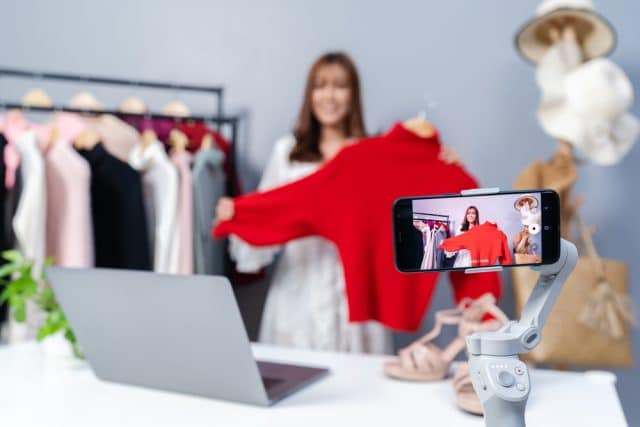Live video commerce: China leads the way, the US catching up fast

It’s estimated that there will be 2.14 billion global digital buyers in 2021. Naturally, every seller wants a piece of this tempting pie. The result -- e-commerce has become more and more crowded as a large chunk of traditional brick-and-mortar sellers is shifting online.
Also, in a traditional e-commerce setup, the customers are expected to visit your website, browse for products, and buy what they want. Though this is the modus operandi of any e-commerce business, there lies an important flaw underneath this string of steps -- "over-reliance on customers to visit your platform."
In other words, you have to wait for the customers to come in search of you!
This massive influx of new e-commerce sellers and the above inherent flaw means the vendors have to keep wearing their creative hats and constantly come up with innovative solutions to beat the competition.
The Solution: Live Video Commerce
Some time back, the internet and social media gave birth to a new channel to reach customers -- Live Video Commerce. Through a live streaming platform, the sellers were able to connect with customers in real-time and sell products in a more natural and non-pushy way.
However, the popularity and acceptance of Live Selling have always been quite disproportionate in the world. China, in particular, has seen better success than the US or Europe. For instance, in 2020, over $125 billion in e-commerce sales in China was via live selling channels. In comparison, the United States managed just $6 billion.
Why Live Video Commerce was a raging hit in China
Here are three reasons behind the extraordinary success of live video commerce in China:
- E-commerce already had a strong foothold in China, and online shopping was nothing short of an addiction for the Chinese audience. This is primarily attributed to the presence of major e-commerce platforms like AliExpress, Tao Bao, JD, etc. Live selling became the natural addition to quench this addiction of the Chinese audience.
- For the Chinese, live selling is not just a channel to buy new products; it is also a source of entertainment. The Chinese spend a significant part of their time online, which is not the case with other countries.
- The Chinese have cross-functional platforms run by giants like Baidu, Alibaba, and WeChat, which enable sellers to access various selling features on the same platform. This is a major gap that is yet to be filled in the other countries.
The US: Inching Closer to China
Although the US is comparatively slow in adopting live video commerce, they are fast catching up with China. According to Coresight Research, the live selling market in the US will reach $11 billion by the end of this year. The market is also expected to hit $25 billion by 2023. But there is still a big gap between the two countries as the projected market size of live video commerce in China is expected to exceed its $125 billion benchmark in 2021
Mobile app builders are bridging this gap by helping businesses build powerful mobile apps that also facilitate in-app live selling. This greatly helps the sellers to hop onto the m-commerce bandwagon and start selling their wares instantly through live video commerce.
Two Countries, Two Models, Two Different Results
Now let us address the elephant in the room -- why the US hasn’t embraced live video commerce to the extent of China. After all, there are no shortages of enthusiastic internet users in the US, and the disposable income is also high. So, when exactly did this burgeoning gap form between the two countries?
To answer this question, we need to dive deep and understand how the concept of live selling differs between the two countries.
In China, most of the live video commerce is driven by influencers. For instance, take the case of Huang Wei, popularly known as Viya. At the age of 35, she is a millionaire and has successfully sold products worth billions to the Chinese audience. In March 2020, she had hit a record-high audience of more than 37 million for her live selling show -- that’s bigger than the Oscars!
Viya and other Chinese influencers use their large following not just to promote products, but to negotiate with companies to give heavy discounts to their followers. This means more followers for the influencers and faster sales for the company -- a win-win for all. This is one of the main reasons behind the staggering volume of live video commerce sales in China.
On the other hand, the live video commerce model in the US is usually not influencer-driven. They rely on the in-house team or the brand/boutique owners themselves to conduct the live video sale, who may not have the huge following influencers usually have.
The Road Ahead
To reach the volume enjoyed by Chinese sellers, the US sellers have two options:
Option 1 -- Join hands with marketplaces
Sellers can try their hand in marketplaces like Amazon where hundreds of brands, sellers, and influencers are already live-streaming. Consumers love varieties and will flock to such platforms for the luxury of picking one from many options.
Option 2 -- Blend m-commerce with live selling
So far, most US sellers have not come face to face with a platform that combines e-commerce, mobile app, and live selling into a single platform. These sellers are losing out on a wonderful opportunity to connect with their customers anytime with a single click. Now you might wonder -- Why bring mobile apps to the equation?
Remember -- everyone has a smartphone today, and the competition between mobile users and computer users is shifting heavily in the former’s favor. Your prospects carry their phones everywhere and consume content and media on the go. Live selling takes advantage of this. Together they take your products to consumers anytime, anywhere. In short, this is the perfect way to scale up the volume rampantly.
This will ultimately help the US sellers to reach what their Chinese counterparts are achieving thousands of miles away in the world of live video commerce.
Image credit: BaLL LunLa/ Shutterstock

Baskar Agneeswaran is currently the Chief Executive Officer at Vajro, a technology company dedicated to enhancing the mobile app experience for small to medium businesses. Leveraging his years of experience in AI- and software-driven solutions, Vajro is becoming one of the global leaders in live video commerce technology.